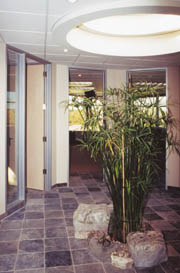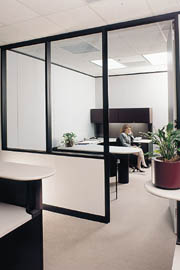What's a wall system? Ceiling systems are constructed from prefinished panel and grid members. Everyone is familiar with ceiling systems. They are used in most commercial and institutional interiors for acoustical and access reasons.
Predecorated panels and exposed framing for wall systems (such as door frames and top track) snap together in much the same way as a ceiling system.

Snap up
Why did the schools go with wall systems? For starters, the director of construction for the local school district learned that wall systems cost about 10 percent less than fixed drywall with field applied vinyl wall covering and insulation for fire and sound ratings equivalent to wall systems. Costs vary from market to market but fixed drywall, which is insulated and covered with field applied vinyl, can cost from $45 to $48 a linear foot.After their first job, the school system construction team learned that wall systems save about one-third of the interior build-out time. There is no joint compound, mortar or paint to dry as in site-built partitions. This creates schedule and cost savings.
When the schools go into operation, teachers and maintenance personnel work to keep wall systems in specifications for future schools. This is the main reason for wall systems. They appreciate how the factory-applied wallcovering holds up under school use. And the fact that individual panels in the wall system can be replaced as needed (just as ceiling panels are). This eliminates the need to paint or redecorate an entire wall when only one or two panels are damaged.
"This surface covering product is designed to outperform site installed paint," says Barry Bastian, marketing director with OMNOVA Solutions, whose DiversiWall wallcoverings are one of the systems installed through schools. "The breathable surface covering means less problems with mold growth inside drywall."

Education construction
The key to a first specification for wall systems in a particular school district is a proper introduction to these walls and their use in schools. An available 3/4-inch-thick-by-24-inch-wide panel is much more rigid than site built commercial drywall, which utilizes 5/8 inch by 48 inch panels. While the 3/4-inch panel is not as rigid as the masonry wall that most school districts have used in the past, they are a step in that direction. Wall systems have not yet been utilized in high schools; "bigger toys for bigger boys," said one school district super.Schools utilize wall systems in ways that are different from their traditional use in offices. In the past, wall systems were installed on top of carpet or carpet squares. Not in schools. Walls are not relocated often during the 50-plus year life of a school building; therefore, the walls are set directly on the subfloor.
The most common wallcovering specified in schools is heavy sackcloth. This is typically a 15-ounce backed vinyl wallcovering. This material accepts tape, tacks and staples, and is almost completely self-healing. No need for tack boards; the entire wall can be used to display visual aids.
"This vinyl is made of coated fabric that will wear almost indefinitely and stay new looking for years," says Bastian. "It is entirely washable. Dirt and such wash away easily with basic houseware cleaning supplies."
Sidelight glazing components are utilized on many wall system installations, creating visual interest while maintaining acoustical privacy.
Many other advantages accrue to school districts that use wall systems. These modern schools are very quiet compared to their old counter-parts with masonry walls and tile floors. The best wall systems utilize only four basic multi-use parts, which can build out most wall and intersection details. Aluminum top track can be drilled at any time in the future to accommodate a vertical electrical or communications drop at any point in the wall. Steel top track comes with holes prepunched every 6 inches for the same purpose. Add the available non-handed, self-mortising door frames and you have a wall which is easy to order, install and maintain for the life a school building.
Sidebar
Vinyl solutions
Specifying wallcoverings for office and other commercial interiors can be enjoyable and challenging. With the wide range of colors, textures and patterns available, wallcovering in most cases adds more to the overall design effect than any other wall treatment. Wallcovering is by no means the only answer but often it's the correct solution for a space designing problem.In office planning, as in residential space planning, cost is usually the deciding factor. It is not unusual for long-planned, carefully considered vinyl wallcovering to be the first thing cut from the budget. Why? Because it is very difficult to convince clients that a wallcovering has a functional bearing. They can't visualize the finished result by looking at a small sample and because they can't visualize the end result, the vinyl is not important to them. Sound familiar?
Properly selected and professionally installed vinyl wallcovering will outlast a painted wall surface in durability and beauty. With the vinyl wallcovering, one only has the cost of initial installation and must wash it every so often. With paint, one must re-paint every two or three years-with all the inherent mess, smell, disruption, etc. Of course, in an office this means paying expensive overtime to have the work done at night, or losing valuable work hours while the job is being done. This lost-time factor might be a fairly convincing argument in favor of vinyl.
A few years ago, Jim Hite developed a formula comparing paint to vinyl wallcovering, providing the cost breakdown. A corrected formula, updated to consider increased costs, is printed in the chart.
Remember to remind clients that vinyl wallcovering is often more cost effective than painted applications because vinyl is more durable and less expensive in the long run.
Painting
Assume the cost to prime one square foot is $0.45 per square foot. (This is based on a quotation of $173 for materials and labor to paint a room of 12 feet by 12 feet by 8 feet or 384 square feet, assuming paint color is the same or darker than the wall so that additional coats of paint are not necessary.)Assume repainting every three years to cost $0.45 per square foot, which does not include the painter's overtime and/or inconvenience to office staff regarding furniture moving.
Time (Years) Cost/Square Feet
0 $.45
3 $.45
6 $.45
9 $.45
12 $.45
15 $.45
After 15 years, the cost of maintaining one square foot with paint is $2.70 ($1,991).
Vinyl wallcoverings
Cost for purchase and installation of wallcoverings is $15.17 per square yard or $1.69 per square foot. Assume a worker to wash vinyl wallcoverings every five years at $6 per hour or $0.10 per minute. Given it takes approximately three minutes to wash one square yard of vinyl (9 square feet) or 0.333 minutes per square feet, the cost to wash a square foot is $0.033 cents. A room of 12 feet by 12 feet by 8 feet has 384 square feet, which would take 128 minutes or about 2 hours to wash.Time (Years) Cost/Square Feet
0 $1.69
5 $.033
10 $.033
15 $.033
After 15 years, one square foot of wall covered by vinyl wallcovering has a cost of $1.79. From this, the vinyl saves $0.91 per square foot over paint. This does not consider the problems of moving furniture for painting or the added cost of painting on overtime at night. Also, the salary of painters will rise sharply over the next 15 years, as compared to wall washers.
Specific offices or work areas must be expensed out to consider all costs involved as realistically as possible, covering all possible aspects of the situation.
The per-square-foot costs of $0.45 for paint and $1.79 for vinyl wallcoverings include both materials and installation. It should be considered that this is a straight-line formula which does not account for inflation, increased cost of money, increased labor costs and increased cost of materials over the time of the estimate. For the most part, these conditions favor vinyl wallcovering, bringing down the cost-effectiveness per year even further.
By plugging in the actual figures of paint vs. wallcovering for an office 12 feet by 12 feet by 8 feet or 384 square feet (4 walls by 8 feet by 12 feet), the cost breaks down as follows:
Accumulative cost comparison
PaintYears Cost
0 .45 X 384 = $172.80
3 = $345.60
6 = $518.40
9 = $691.20
12 = $864.00
15 = $1036.80
Vinyl Wallcoverings
Years Cost
0 $1.79 X 384 = $687.36
5 $0.33 X 384 = $700.04
($12.68)
10 = $712.72
15 = $725.50
Savings over the 15-year life of the materials is $311.30 for wallcovering, or 30 percent less than the price of painting.

Report Abusive Comment